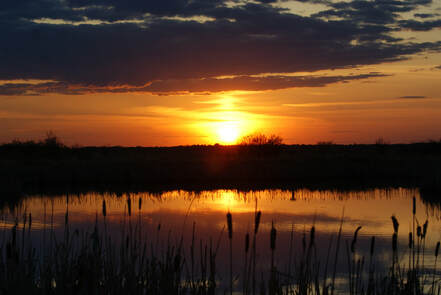The changes to the Alberta Wildlife Regulations came into effect on August 25th 2020 and in order to limit disturbance to staging swans Kimiwan Lake has now been reclassified as a Provincial Game Bird Sanctuary.
The fall staging surveys that the Kimiwan Lake Naturalists have been completing since 2001 was the critical piece of data that supported the maintenance of the season game bird sanctuary status.
The fall staging surveys that the Kimiwan Lake Naturalists have been completing since 2001 was the critical piece of data that supported the maintenance of the season game bird sanctuary status.
Kimiwan Lake

Kimiwan Lake is a large (4046 ha, 10,000 acres), shallow (mean depth of 0.5 m), freshwater lake without a natural outlet, surrounded by a mix of agricultural and forested land. It has a relatively small drainage basin of 161 km² and as it is a broad and shallow lake, it is subject to high evaporation rates in the summer resulting in susceptibility to short term water level fluctuations. Along most of the shoreline, the lakeshore is characterized by marsh and mud flat habitats often with a wide band of emergent shoreline vegetation composed of thousands of acres of cattail hemi-marsh habitat.
The water levels in the lake fluctuate between years as well as within each year. Today, the lake level is controlled through several water control structures designed to maintain the water elevation at a more shallow depth than its natural range would likely have been. The target water elevations are 618.9 meters (geodetic elevation) in the spring and 618.7 metres in the fall. Since the official monitoring of the lake’s water levels commenced, the historical maximum observed elevation was 619.924 metres in June 1978. Seniors in the region fondly recall when the water levels in the 1940s and 1950s reached the height of Highway #2 along the south side of the lake. There was large dock that facilitated boat launching and swimming.
The installation of the control structures in the 1970s served to limit the amount of agricultural land subject to flooding. Similarly, extensive drainage of agricultural lands south of McLennan, now moves runoff west into the Little Smoky River via a series of major ditches, instead of into Kimiwan Lake. At times, surplus water is transferred from nearby Winagami Lake in order to supplement lower lake levels at Kimiwan Lake. It’s a scenario that can limit the long term sustainability of the lake. However, despite these challenges, the lake has generally held its own as a shallow marsh and was last totally dry in 2003. Since the outlet structures were constructed, the maximum observed elevation was 619.673 in June 1997. The high water levels of 1997 resulted in significant damage to the wooden walkways and gravelled paths of the Birdwalk. From flood in 1997 to drought in 2003. That’s Alberta!
If Kimiwan Lake dried up periodically, would that be a travesty? Well, to answer that question, it helps to understand the ecology of prairie wetlands and the various bird communities that depend on them. Prairie wetlands typically undergo a seasonal drawdown of water levels following spring run off. This allows new vegetation to colonize exposed bed and shore, rejuvenating and diversifying plant communities. Not surprisingly, under these situations, different bird communities benefit in both the short term and the long term according to the water depth and plant communities. So, it’s not an easy question to answer. If the lake has exposed mud flats in May and August, tens of thousands of Arctic-nesting shorebirds will use the lake as a key refuelling stopover during migration. If the water is 1.5 m deep, there will be very few shorebirds present. Certainly, a dry lake bed will be devoid of waterfowl. Periods of prolonged absence of water from the lake would indeed be detrimental to most bird species.
As an interesting note, in 2004 and following the absence of any water in the lake in 2003, the growing conditions on the lake bottom favoured a plant called marsh ragwort. Millions of this native plant sprouted and matured on the lake bottom and their orange blossoms were a sight to behold. Local honey producers indicated that their pollen production that year was one for the record books.
